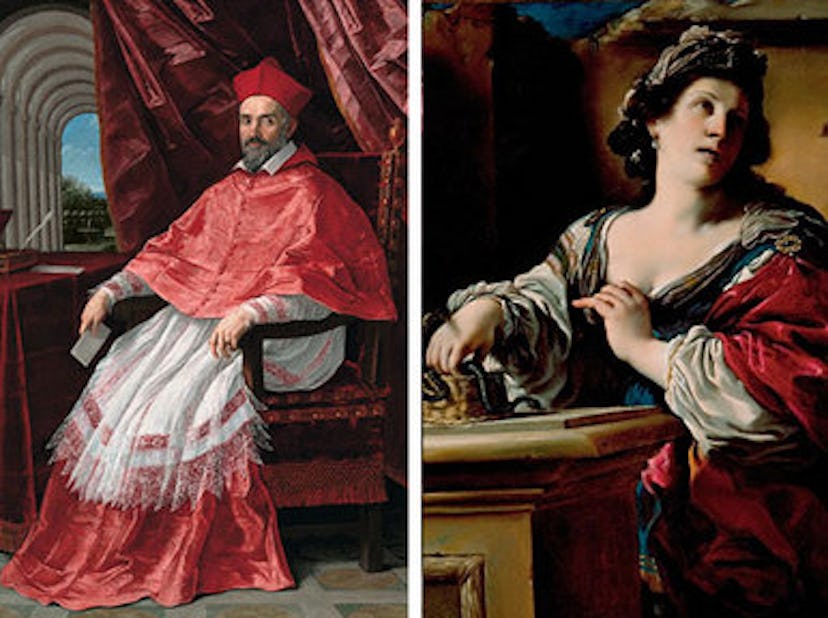Red Carpet Tips from the Old Masters
The Oscar nominations came out today, and Hollywood's ritualized adoration of its top talents put me in mind of—believe it or not—an exhibition currently at the Getty Center here in L.A. called "Captured Emotions, Baroque...

The Oscar nominations came out today, and Hollywood’s ritualized adoration of its top talents put me in mind of—believe it or not—an exhibition currently at the Getty Center here in L.A. called “Captured Emotions, Baroque Painting in Bologna, 1575-1725.” It may sound stuffy, but the high Renaissance was time of inflamed passions, melodramatic imagery and—as I was reminded by these paintings of saints, sinners, popes and pagan gods—it was the Age of Fabric. Nearly every painting in the show offered a flourish of billowing cloth. Walking through the galleries the other day, I found myself thinking there was a lot that modern-day actresses could learn about Oscar dressing from these long-dead dignitaries.
In deference to the trinity of actresses in Doubt—Meryl Streep, Amy Adams and the remarkable Viola Davis—let’s begin with the cautionary example of Guido Reni’s 1625 Portrait of Cardinal Roberto Ubaldino (above, left). It’s only incidentally a picture of His Eminence, as all the elaborate garments end up stealing the show. (The starched collars, moiré silk robes, pin-pleated linen, et al.) Note to all actresses: don’t let yourself be upstaged by your gown. Try to be more like the opulently bedecked superstar in Guercino’s The Suicide of Cleopatra (1621) (above, right). She’s got the robes and the jewels, but the moment is all about her. (Looking at the portrait, I was also reminded of Davis’s turn in Doubt as a woman bearing sorrow with immense dignity.)
From left: Disegno and Colore, Winslet, a look from the Dolce & Gabbana spring 2006 runway show.
The Old Masters weren’t afraid to go over the top, and they did so with virtuoso flair. Check out the masterful styling in Guercino’s Disegno and Colore (1640), which dramatizes the debate between the role of drawing (disegno) and color (colore) in painting. Advocating one point of view, an old man holds up a pencil drawing of cupid, while the other side is of the argument is represented by a voluptuous beauty—think Kate Winslet—who paints the same image in life-like color. She of course steals the show, thanks in no small part to her fabulous get-up: a celestial blue gown with the hem turned back to reveal a hot orange lining; an ivory blouse with voluminous sleeves in pale hyacinth; a mustard-brown shawl as weightless as shatoosh and edged in somber vermillion, and then, literally topping it all, a cap with circus stripes of pure blue and red. Guercino had a couturier’s eye for colore and I only wish he were still here to style Winslet or Benjamin Button‘s Taraji Henson, who unfortunately tends to bland herself out in neutral-tone sheaths.
Anne Hathaway (above, right) looked good at the Globes, but for great make-up, she might ponder Guido Reni’s Saint Cecelia (1606) (above, left) to learn the secrets of a perfect chaste-sexy look: pale porcelain skin, natural eyes, a hint of blush and then those sensually flushed lips.
Those are the fashion Dos. Under the category of fashion don’t is Francesco Albani’s Holy Family with Angels (c. 1613-15) (above, left), which proves definitively that strawberry blondes—hink Melissa Leo (above, right) in Frozen River—should stay away from red dresses. The poor Madonna looks positively washed out. Red is for the Penelope Cruzes and Marissa Tomeis of the world.
And finally, a lesson in comportment comes from Reni’s Saint Apollonia (c.1623) (above, left). She’s perfectly attired in a shell-pink shift, and although she’s about to have her teeth pulled by a masochist with giant iron pliers—the prelude to her martydom—Apollonia maintains a look of graceful forbearance in the face of her adversity. This masterpiece demonstrates how a lady should comport herself while enduring an aggressive media assault on the red carpet. Take note, Angelina.
Incidentally, the timeless lessons that “Captured Emotions” had for men were much simpler: 1) buff up, since both sinners and saints look best with a gym-toned physique and 2) a fitted jacket in understated black is always the surest bet. Unless you’re man enough to don ecclesiastical robes.
All paintings courtesy of the Getty. Photos: Kate Winslet: Donato Sardella ; Hathaway: Getty Images; Jolie: WWD staff.